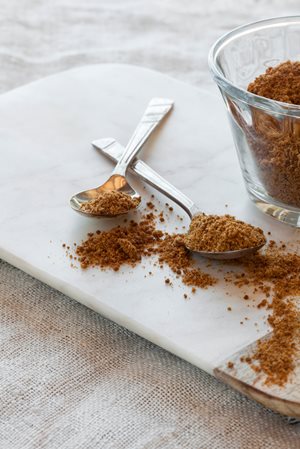When asked what’s the best way to grocery shop, we’ve all probably heard the tip, “Shop the perimeter.” Although that is a great grocery hack, you can still shop the entire store, center aisles included, while supporting your lifestyle. We asked a dietitian what’s the best way to shop the center aisles of the grocery store and here’s what she had to say.
#1 Asses the Aisles
Before shopping the center aisles of your local grocer, assess the inner aisles. By planning ahead of time what aisles carry your favorite pantry staples, you can avoid mindlessly wandering down unnecessary center aisles.
#2 Research Food Brands and Companies
Before venturing down the center aisles, research food brands and companies whose mission is to use nourishing ingredients that work harder for your body. Food should give your body more of the good stuff (think protein, vitamins, minerals and phytonutrients) and less of the not so good stuff like grains, sugar and gluten, so be sure to read food labels.

#3 Read Ingredient Labels
If you don’t recognize an ingredient then odds are your body won’t either, so look for brands that handpick their ingredients with a purpose. Fill your grocery cart with foods that only include nutritious ingredients, nothing artificial like additives, artificial dyes or fillers.
Alexis Joseph, MS, RDN says, “Reading labels can be a doozy, especially when you’re trying to make that grocery trip as quick as possible.” Here are a few tips Joseph recommends when reading ingredient labels:
- Start with the serving size and remember the information on the nutrition label reflects only one serving of that food or drink.
- Rather than focusing on calories, focus on items made with real, recognizable ingredients that will be both satisfying and nourishing.
- Aim for items with ingredients that contain fiber and protein from whole foods versus those added in processing. (Think fiber from almonds versus inulin, or protein from eggs versus soy protein isolate.)
- Be mindful of sugar and remember that the sugar found in sources like apples or dates comes in nature’s package with fiber and phytonutrients, while added sugars do not.
- Choose items with fewer than six grams of added sugar per serving and opt for more natural sweeteners like raw honey or coconut sugar, which contain a bit more nutrients than more processed sweeteners like cane sugar.
- As far as the fat content on a label, remember that fats are an important staple in any healthy diet. Rather than avoiding high-fat foods, go for mostly unsaturated fats and steer clear of artificial trans fats, known as “partially hydrogenated oil.”
#4 Go Grain-Free
Grains are notorious for containing gluten and lectins, both of which have been linked to gut irritation and inflammation within the body. Naturally rich in phytates, grains can also inhibit nutrient absorption. When shopping the center aisles of the grocery store, be sure to look for grain-free options so you can avoid any inflammation issues and potential tummy troubles.

#5 Sweeten Smartly
When going beyond the perimeter and venturing into the uncharted (yet fairly harmless) territory of the center grocery aisles, Joseph recommends to aim for foods that contain six grams or less of sugar per serving. Excessive sugar intake may lead to inflammation, so look for items that use more natural, unrefined sweeteners like coconut sugar or raw honey and consume them mindfully. We all love our sweets, especially when we can enjoy them in a more wholesome way!
#6 Side with Sprouting
Sprouting is the process of soaking seeds for several hours in order to unlock the seed’s outer coating to get to the good stuff. This process makes the seed’s vitamins, minerals and enzymes easily accessible for your body to use. Plus, sprouted seeds are higher in both protein and fiber. (Win win!) When selecting items like breads and crackers, look for companies that use a sprouting technique.
#7 Go Homemade
If you find yourself shopping the center grocery aisles for condiments like salad dressing, ketchup and other condiments, why not try making your own homemade version instead? Research recipes with ingredients you recognize then be sure to make a large batch and properly store any excess to use at a later time.
The next time you go grocery shopping, don’t solely stick to the outer perimeter. Instead, embrace the center aisles and use these seven tips to shop smart!